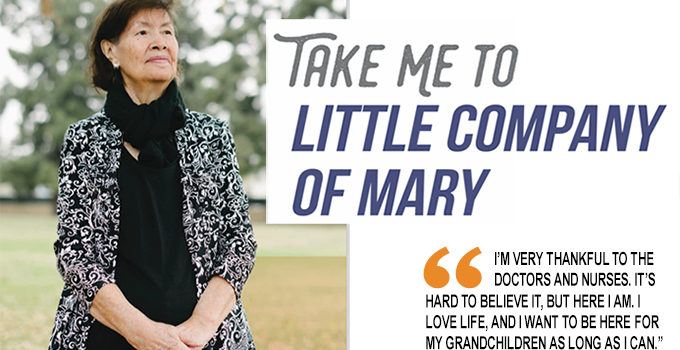

Stroke Care In the South Bay: “Take Me to Little Company of Mary”
by Zara Jethani
Written by Kate Gammon Photographed by Lauren Pressey
As the first Comprehensive Stroke Center in the South Bay, Providence Little Company of Mary Medical Center Torrance has put together an unbeatable team to save patients.
On January 8, Aida Fernandez was coloring her hair in the shower when she felt her legs starting to get weak. Aida, who just turned 81, was planning to fly to Texas a few days later for a wedding, and she wanted to look nice for the event. But after her legs got weak, she turned off the water and lay down in her bathtub; it took her a few minutes to get up.
Eventually Aida was able to dry and dress herself. She then moved to the bedroom, where she stretched across the bed and called her husband to say she wasn’t feeling well. “After that, I remember nothing,” she says.
Aida’s husband and daughter-in-law, Carol Fernandez, soon rushed to the house, where they found the bedroom door locked. Carol could hear a faint voice on the other side of the door. After a few futile attempts to knock down the bedroom door, Carol called Aida’s son, Luis, who dialed 911.
The paramedics arrived quickly and determined that Aida was having a stroke.
Luis reached the house as Aida was being taken out of the house on a stretcher. “She wasn’t totally out of it, but her eyes were kind of drowsy,” he recalls. “I held her hand, and she just looked at me, unable to say anything.”
After assessing Aida using a set of criteria, the paramedics made a quick choice to pass two hospitals on the way to Providence Little Company of Mary Medical Center Torrance. They wanted to make sure Aida would arrive at a hospital with the staff expertise to care for the sickest of stroke patients. The whole journey took about 20 minutes.
When Aida arrived, the emergency department team including Andrew Louie, MD, as well as two vascular neurology specialists, Allison Arch, MD, and Jason Tarpley, MD, were waiting for her. Dr. Arch remembers that the hospital received the information ahead of time, as they usually do, to let the specialists know someone with a potential stroke was about to arrive. “We get information about a patient’s age, condition and their LAMS score, which lets us know how serious the stroke is,” says Dr. Arch. “Having that information ahead of time lets us prepare.”

Together with the emergency department team, Dr. Arch and Dr. Tarpley met Aida in the ED and took her to get a CT scan. They suspected right away she had a large-vessel occlusion, and they read her CT imaging results as soon as they were available. The doctors’ suspicions were correct: Aida had a large-vessel occlusion. The stroke was on her left side, paralyzing her on the right side and affecting her language and cognition.
“Right away we knew we had to open her vessel,” says Dr. Tarpley. When there is a clot in the brain, all the area of brain that is starved of blood flow is plummeting to its death. “You’re losing about 2 million brain cells per minute,” he explains. “So the faster you get the blockage open, the better.” Studies show that for every 20-minute delay, you’re 10% less likely to have a good outcome after a stroke.
“We try to treat every patient as if it was our mom coming in,” says Dr. Arch. The team aims to get them into the interventional lab—where clot-removing surgery can happen—within an hour. That requires a lot of departments to work seamlessly together, including neurology, radiology, the emergency department, the neuro ICU. “One thing Little Company of Mary does so well is get all the moving parts on the same page,” says Dr. Arch. Having in-house vascular neurologists like her means everything can happen faster.
Moving from one hospital to another takes longer: often 80 minutes or more, which would equate to a 40% to 50% decrease in the brain blood flow, according to Dr. Tarpley. Aida benefited by passing two other hospitals to arrive at a comprehensive stroke center right away.
THE SURGERY
Taking out a clot—also known as thrombectomy— is a minimally invasive procedure. Dr. Tarpley put a catheter about the size of a phone charging cable into Aida’s leg artery, then navigated a clot-removing device up to the base of her brain. Through that catheter, he put a tiny tube which is 21/1,000th of an inch in diameter. A tiny wire drove that tube into the area of the brain where the clot was located.
“It is relatively complex, but if you go to a hospital that does it a lot, you should be able to get it done quickly,” says Dr. Tarpley. His record reaching the clot is just 10 minutes. “They don’t all go that way, but it is something we have to strive for.”
A stent retriever is deployed into the clot, which is a gooey, rubbery, red mass, and the clot is pulled out with suction, opening the artery.
The quick surgery had immediate results. “Right on the table, Aida started moving her right side and talking to us,” recalls Dr. Tarpley. It’s not that rare to see patients make a huge improvement on the operating table, he says. “They go from being blind and unable to speak to immediately being nearly normal.”
Dr. Tarpley asked Aida to identify his eyebrows and knuckles, testing her speech and language functions. She was able to speak and understand.
If she had had the stroke a day before, she may not have had the same outcome. That’s because Aida was the first patient treated after a change in paramedic routing protocol. Any patients with suspected large vessel occlusions must now be taken directly to a stroke center with clot removal capabilities rather than primary stroke centers. That’s why she bypassed two community hospitals to reach the medical center in Torrance. Getting effective treatment quickly after a stroke is critical, and it would have taken time for Aida to go to her local medical center and then be transferred to a Comprehensive Stroke Center like Providence Little Company of Mary Torrance, where the surgery to remove the clot could be performed. Dr. Tarpley opened her blood vessel in just 27 minutes—a critical factor in her positive recovery.
The first thing Aida remembers after collapsing on her bed is being in the hospital, surrounded by two of her three children, and her nieces and nephews. She was surprised to learn she had suffered a stroke and even more surprised to learn she’d had surgery to remove the clot.
GATHERING THE TEAM TOGETHER
Aida’s quick stroke treatment at the medical center is a testament to how protocols have changed for stroke patients. Starting January 8, paramedics assess patients and then route them to a comprehensive stroke center, as long as that hospital is within a 30-minute drive.
Comprehensive Stroke Center Certification recognizes hospitals like Providence Little Company of Mary Torrance meet standards to treat the most complex stroke cases. Eligibility standards include elements like 24/7 basic and advanced imaging techniques, and physicians trained in vascular neurology, who are on call around the clock. They also require hospitals to have specialized facilities where procedures like the one Aida had are performed. The hospital has trained nurses with stroke care expertise across the entire hospital, from the emergency department to the stroke units.
“We see a very large number of strokes at this hospital, averaging more than 700 every year,” says Richard Glimp, MD, Chief Medical Officer of Providence Little Company of Mary Torrance. Strokes can affect people of all ages, although older people have a greater stroke risk.
The hospital leadership had been noticing a trend in increased numbers of patients with strokes and wanted to provide the best care for the South Bay community. But when a complex stroke came in, the medical center would have to transfer them to neurosurgical care. “It didn’t sit right with us, putting a patient on an ambulance on the 405,” says Dr. Glimp. “So we started looking at upping our game about two years ago.” The medical center began to fulfill the requirements by building a team, including partnering with Pacific Neuroscience Institute physicians. They also recruited neurohospitalists, neurointerventionalists and neuroscience critical care specialists.
This process has evolved over time, according to Jamie Kahn, MD, Emergency Medical Services Base Director at the medical center. “While the designation came quickly, we have been working on all the pieces for a long time, because we want to be able to provide these exams and specialized services to our community,” she says. “We put in place all the elements that best serve our patient population and our community.”
Why does it matter? Because as doctors often say, time is brain. “Strokes in general are critically time-dependent,” says Dr. Kahn. “Any delay that occurs in removing a clot and restoring blood flow to the brain reduces the likelihood of a good outcome.”
Dr. Kahn stresses how many people have to be onboard to act quickly when someone has a stroke. First, members of the community have to be aware of the signs of a stroke and call 911 immediately.
As a Comprehensive Stroke Center, the medical center provides community education events to help people know how to act when they witness a stroke. Then Emergency Medical Services and its medical directors have to train and educate paramedics about identifying which strokes could benefit from surgery and get them on board with changing the routing to a Comprehensive Stroke Center. EMS responders assess a patient using what’s known as the Los Angeles Motor Scale (LAMS) to determine the severity of the stroke. Patients with the most severe strokes are then transported to one of 14 designated Comprehensive Stroke Centers in Los Angeles County.
From there specialized stroke nurses, who take calls from paramedics, have to help relay the information. Emergency department physicians are trained in stroke identification and management and initiate specialized critical care. “The depth of the team caring for these critical patients is just huge,” she adds.
Dr. Glimp sees the potential to change health care for the better in the South Bay community. “Our goal is that no patient in the South Bay will ever have to leave the South Bay for neurologic care,” he says. “That’s really the goal around stroke care and really all neurological care.”
Los Angeles County is over 4,000 square miles with 10 million people, so there’s an enormous need for hospitals to make the commitment to become a Comprehensive Stroke Center, says Marianne Gausche-Hill, MD, Medical Director for Los Angeles County EMS Agency. “We are fortunate that in the South Bay, Providence Little Company of Mary has made that commitment.”
ROAD TO RECOVERY
Aida is back home and recovering well. She goes to speech and exercise therapy at Providence Little Company of Mary Medical Center San Pedro (a rehab center that is ranked in the top 2% of the country) and has resumed many of her favorite activities, like cooking for her grandchildren and spending time with family. “She’s almost 100%, about 95% right now,” says son, Luis. “She’s like before, her mind is fine. She has energy now, she’s walking like she used to. You could trick someone by telling them she never even had a stroke.”
 Dr. Tarpley says the new routing procedures have really been a dream come true for patients and the medical center. “We have seen the benefit of patients coming directly to us.” In fact, in January after the protocols changed, he did six or seven thrombectomies like the one Aida had during the nine days he was on call at the hospital. “We have more strokes at Providence Little Company of Mary Medical Center Torrance than any other Providence hospital,” he adds. “Ultimately the certification means that we can take care of patients who are neighbors and need advanced care.”
Dr. Tarpley says the new routing procedures have really been a dream come true for patients and the medical center. “We have seen the benefit of patients coming directly to us.” In fact, in January after the protocols changed, he did six or seven thrombectomies like the one Aida had during the nine days he was on call at the hospital. “We have more strokes at Providence Little Company of Mary Medical Center Torrance than any other Providence hospital,” he adds. “Ultimately the certification means that we can take care of patients who are neighbors and need advanced care.”
Dr. Tarpley points out that even though large vessel occlusion is the main driver of routing, the neurology specialists at the medical center can handle everything patients may need in neurology—no matter how complex or serious.
What makes Providence Little Company of Mary Torrance especially able to treat all kinds of conditions is the medical center’s complement of neurology and neurosurgery specialists, explains Dr. Tarpley. The hospital has specialist physicians in neurocritical care, vascular neurology, neurointerventional surgery and neurosurgery. Other community hospitals simply don’t have this level of expertise.
Luis is thankful for the quick thinking and assessment of the paramedics. “A lot of things had to work for this outcome to happen,” he says. “Even a day before, it would have been different.” The paramedics told Luis that sometimes patients or families argue with them about which hospital to drive to. “Luckily, we just said, ‘OK, we trust you guys,’” says Luis. “I’m so glad we did.”
“I’m very thankful to the doctors and nurses,” says Aida. “I’m so happy it makes me cry. It’s hard to believe it, but here I am. I love life, and I want to be here for my grandchildren as long as I can.”
Original article published in the Spring 2018 issue of “In Good Company”
About the Author

Zara Jethani
Zara is the marketing director at Pacific Neuroscience Institute. Her background is in molecular genetics research and healthcare marketing. In addition, she is a graphic designer with more than 20 years experience in the healthcare, education and entertainment industries.
Last updated: August 2nd, 2019